Climate
-
Temperature
18-32°C -
Rainfall
40cm -
Sowing temperature
25-30°C -
Harvesting temperature
16-18°C
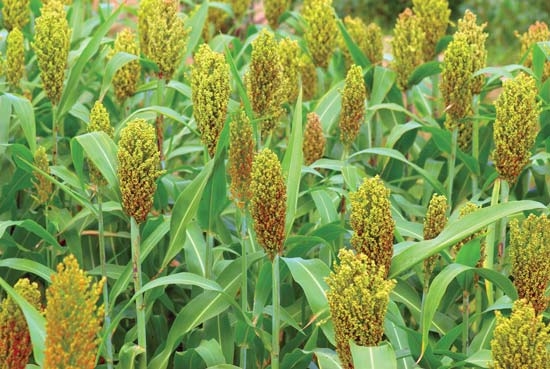
















It grows on wide range of soil but sandy loam soil with good drainage is suitable for cultivation. pH of 6 to 7.5 is ideal for cultivation and better growth.
HJ 513: Single cut variety, suitable for early as well as late sowing. It is tall variety gives resistant to foliar disease. Gives average yield of 200 qtl/acre.
HC 308: Tall variety show resistant to foliar disease. Also it is resistant to drought. Ready to harvest in 115 days. Gives average yield of 212 qtl/acre.
HC 260: Early maturing, tall and juicy variety. Gives average yield of 152 qtl/acre.
HC 171: Tall variety suitable for sowing in kharif and summer season. Ready to harvest in 110 days. Gives average yield of 160 qtl/acre.
HC 136: Multicut variety suitable for sowing under irrigated conditions. Ready to harvest in 140 days. Gives average yield of 160 qtl/acre.
Sweet sudan: Tall, Multicut variety suitable for sowing under irrigated conditions. Gives average yield of 300 qtl/acre.
Haryana chari: Single cut variety, ready to harvest in 100 days. Gives average yield of 120 qtl/acre.
Other state varieties
SSG 59-3
Pusa Chari
HC 136
Pusa Chari 9
Pusa Chari 23
MP Chari
HC 260, HC 171
Harasona 855 F
MFSH 3
PCH 106
Safed Moti (FSH 92079)
Pant Chari 5 (UPFS 32)
CSH 20MF
Haryana Jowar 513
Give one deep ploughing every year in shallow to medium deep soil. Give one to two ploughing followed by 2 criss cross harrowing. Prepare land in such a way that water stagnation will not occurred in field.
Time of sowing
In kharif season, optimum time for sowing is from 25th June to 10th of July.
Spacing
For sowing use spacing of 45cm x 15cm or 60cm x 10cm.
Sowing Depth
Seed should not be sown more than 2-3cm depth.
Method of sowing
In Haryana, jowar is sown by seed drill or Pora method.
Seed Rate
Use seed rate of 20-24 kg/acre for sowing.
Seed Treatment
To protect crop soil borne disease, do seed treatment with 300mesh sulphur powder@4gm and then Azotobacter@25 gm/kg of seed before sowing.
Or use any one fungicides from below
| Fungicide name | Quantity (Dosage per kg seed) |
| Carbendazim | 2gm |
| Captan | 2gm |
| Thiram | 2gm |
Fertilizer Requirement (kg/acre)
| UREA | SSP | MOP |
| 44 | - | - |
Nutrient Requirement (kg/acre)
| NITROGEN | PHOSPHORUS | POTASH |
| 20 | - | - |
Before sowing add 4-6 tons of Farm Yard Manure or well decomposed cow dung in soil. For unirrigated and low rainfall areas, apply Nitrogen@ 20kg in form of Urea@44 kg/acre at time of sowing. For irrigated and high rainfall areas, apply Nitrogen in two splits, first at time of sowing (Urea@44kg) and second (Urea@24kg/acre) one month after sowing.
Jowar crop get affected due to both grassy and broad leaves. Do manual weeding with the help of khurpi 15-20 days after sowing. Spray with Atrazine@500gm/150 ltr water within 7-15 days after sowing. While spraying enough moisture should be present in soil.
Tillering, flowering and grain formation stages are criticle stages for irrigation. In kharif season it required one to three irrigation depending upon rainfall intensity. Under adequate water supply in rabi and summer season, irrigation should be given at all these critical stages.
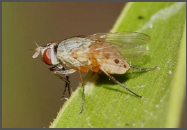
Sorghum shoot fly: They laid eggs on younger leaves. Shoot get dried and produces "dead heart". Side tillers are produces in affected plant. Plant come out easily when pulled out and gives bad smell. One to six week seedlings are more susceptible to this pest.
Do not delay in sowing. After harvesting of previous crop, clean field and remove remains of earlier plants. At time of sowing, soil application of Phorate 10G@7kg/acre or Carbofuran@13kg/acre will help to control it. Before sowing do seed treatment with Imidacloprid 70WS@10gm/kg of seeds. Remove infected seedlings and destroyed them away from field. If infestation is observed Methyl Demeton 25EC@200 ml/acre and Dimethoate 30EC@200 ml/acre.
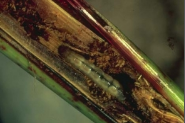
Stem borer: Larvae is of yellowish brown with brown head. Moth is of straw colored. On infestation, withering and drying of central shoot is observed. Bore holes are observed on stem. Series of pin holes on emerging leaves
Set up of light traps till mid night to monitor, attract and kill adults of stem borer. Mix Phorate 10G@8kg/acre or Carbofuran 3G@7kg/acre with sand to make quantity upto 10kg/acre and apply in the leaf whorls. Take spray of Carbaryl 50WP@600gm/acre.
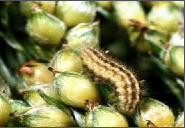
Ear Head bug: When grains are at milking stage, nymph and adult suck juice from grains. Because of it grains get shrink and gives black color. Large number of nymphs are observed on ear head.
On 3rd and 18th days after panicle emergence, spray apply Carbaryl 10D@10kg/acre or Malathion 5D@10kg/acre. Spray with Malathion 50EC@200 ml/acre in 200 litter of water at 10% heading.
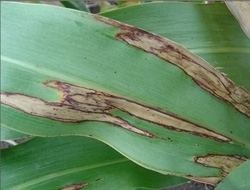
Leaf Blight: In initial stage small narrow elongated spindle shaped spots are observed. On older plants, long elliptical, necrotic lesions of straw coloured observed in the centre with dark margins. It destroyed large area of leaf and give crop a burnt appearance. High humidity, high rainfall along with cool moist weather are favourable for this disease.
Use disease free seeds and resistive varieties. Follow proper crop rotation. Before sowing treat seeds with Thiram or Captan@ 4 gm/kg of seeds. If infestation is observed spray crop with Mancozeb@2.5 gm/Ltr of water, if necessary take second spray with 15 days interval.
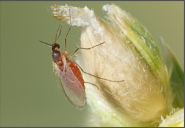
Sorghum Midge: Sorghum midge fly is small mosquito shape. Maggots of midge fly feeds on developing grains. Larvae feeds on the ovaries and destroyed developing grains results in partial feeling of grains. Red ooze from spikelet shows presence of maggots.
Set up light trap to attract midge fly. Apply Carbaryl 10D@10kg/acre or Malathion 5D@10kg/acre on 3rd and 18th day after panicle emergence.
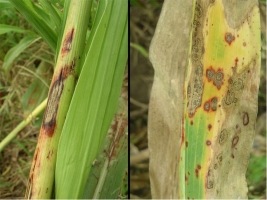
Anthracnose: Small red color spots with white centre are observed on both side of leaves. Numerous small black dots like are seen on the white surface of the lesions. Circular canker is developed on stalk and inflorence. When we split infected stem it shows discoloration.This disease spread in continuous rain, high humidity and temperature 28-30°C.
Avoid continuouse growing of crop. Follow crop roration. Grow resistive varieties. Before sowing of crop treat seed with Captan or Thiram@3 gm/kg of seeds. If infestation observed spray crop with Mancozeb@2.5gm or Carbendazim@1gm/Ltr of water.
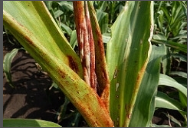
Rust: It affect at any growth stage of crop. Small reddish brown flecks observed on lower surface of leaves. Pustules appeared on both surface of leaves, on rupture they gives reddish powdery mass. The pustules may also occur on the leaf sheaths and on the stalks of inflorescence. Low temperature 10-12°C along with spell of rainy weather is favourable to this disease.
Grow rust resistant variety. If infestation is observed spray crop with Mancozeb@2.5 gm/Ltr of water or do dusting of sulphur@ 10 kg/acre.
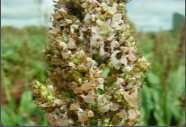
Ergot: Secretion of honey dew from infected florets is main symptoms of this disease. This secretion attracts large number of insects and ants, also head give black appearance. At the base of infected plant white spots on soil is observed. High rainfall, high humidity at flowering stage along with cloudy weather is favorable for spread of this disease.
Grow Ergot resistant varieties. Before sowing soak seed in 2% saline solution, ergot affected seeds float on surface, remove them. Do seed treatment with Captan or Thiram@4 gm/Kg of seed. Spray with Ziram, Zineb, Captan or Mancozeb@2 gm/Ltr at emergence of ear head. Take second spray at 50% of flowering. If necessary repeat spray after a week.
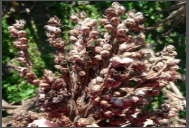
Head mould/Grain mould/Head blight: Moist weather at the time of flowering or grain filling stage causes fungus growth on earheads. Compact heads are more susceptible to this disease.
Avoid late sowing. Grow resistant varieties. Before sowing treat seeds with Thiram@3gm/Kg of seeds. In case of intermittent rain during ear head emergence, take spray of Mancozeb@2.5gm/Ltr of water or Captan@2gm/Ltr of water.
Grain smut/Kernel smut / Covered smut / Short smut: Appeared at time of grain formation in ear. Grains gives dirty white or gray color appearance and get covered with white cream. Affected plants can be detected before the ears come out. They are shorter than the healthy plants with thinner stalks and marked tillering. The ears come out much earlier than the healthy.
Use diseased free seeds and resistive varieties. Follow crop rotation. Before sowing treat seeds with Thiram or Captan@ 3 gm/kg of seeds.
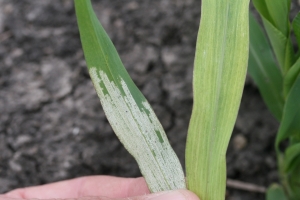
Downy Mildew: Whitish growth is observed on lower surface of leaves. The leaves give green or yellow colouration appearance.
Avoid growing of crop continuously on same field. Follow crop rotation with pulses and oil seeds. Use downy mildew resistive varieties. Before sowing treat seeds with Metalaxyl@4 gm/Kg of seeds. If infection is observed spray with Metalaxyl@2 gm/Ltr of water or Mancozeb@2.5 gm/Ltr of water.
For fodder purpose, harvest crop after flowering stage. For single cut varieties, carry out harvesting 60-65 days after sowing (crop is at 50% flowering). Whereas for multicut varieties, take first harvesting at 60 days after sowing and second harvesting 40 days after first harvesting.
For grain purpose, the right time for harvest is when grains become hard and contain less than 25% moisture. For harvesting sickles are used.
After proper drying carryout threshing operation with the help of sticks or by trampling under bullock feet. Collect grain after threshing operation. Clean and dried them in sun for 6-7 days upto 13-15% moisture content. Then stored them in clean and dry place.
Sorghum is considered to be originated in Northern Africa or at the Egyptian-Sudanese border 5,000-8,000 years ago. It is third major food grain crops of India. It is used as fodder crop also as industrial raw material in various industries in the USA and other country. USA is the largest producer of sorghum. In India Maharashtra, Andhra Pradesh, Karnataka, Madhya Pradesh, Gujarat, Tamil Nadu, Rajasthan and Uttar Pradesh are the important sorghum growing states. In Haryana, jowar is important fodder crop and cultivated in kharif as well as in summer season.
You have successfully login.
Your email and password is incorrect!